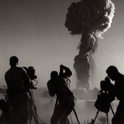There are many powerful moments in Everyone Who Is Gone Is Here, Jonathan Blitzer’s book about migration from Central America to the United States. One comes early on, when Juan Romagoza, the person whose life story most strongly marks its pages and whose words form the title, is on duty as a medical trainee in a Salvadoran hospital in February 1980.
With the help of his colleagues, Juan has just managed to stabilise a young patient who had been dropped off, immobile and drenched in blood, after being shot by police at an anti-government protest. Post-surgery, the activist is in a stable condition and Juan falls asleep by his bedside, unaware of what is close at hand. The sound of boots thudding towards them startles him awake, but by then it is too late. The death squad arrives and riddles the convalescing dissident with bullets.
The junior doctor can only collect the spent cartridge cases and vow not to forget what he has witnessed. He later delivers the evidence to Óscar Romero, the much-loved Salvadoran archbishop who would be assassinated by the far right the following month for standing up for the interests of the poor and the powerless. The Catholic priest’s murder deepened the crisis in which the country found itself, a crisis that only ended 12 years later, when the army and the guerrillas finally ceased their civil war.
Over the next 400 and something pages, Blitzer unravels the troubled history of El Salvador, Guatemala and Honduras, the countries that make up Central America’s so-called Northern Triangle. As well as documenting the instability that has led hundreds of thousands of these countries’ citizens to risk the dangerous journey to the US in recent decades, the author, who works as a journalist for the New Yorker, reveals Washington’s role in it. Take, for instance, the Salvadoran Civil War. Despite knowing that El Salvador’s army was committing atrocities, the US continued to support it, viewing an at-all-costs victory as a Cold War imperative. Not only did it give the Salvadoran military hardware and help fund a rapid increase in army recruitment, but American troops also trained some of the worst Salvadoran human rights violators, including the battalion that carried out the El Mozote massacre, in which dozens of innocent civilians, many of them children, were butchered. The Reagan administration denied the deaths, but the evidence was overwhelming.
‘It’s our bombs, our guns and our mines that made these people refugees’
Given the dangers and horrors lurking in El Salvador, it is no wonder that the number of Salvadorans living in the US shot up from 92,000 in the spring of 1980 to 459,000 by 1990. Nevertheless, those who fled the violence at home struggled to gain legal protection up north. Although the parameters for asylum set out in the 1980 Refugee Act clearly applied to many of them, the US Department of State claimed that they were not in danger back home. Some, such as Democrat politician Joe Moakley, saw this stance as reprehensible: “It’s our bombs, our guns and our mines that made these people refugees,” he said. Despite such protests, Salvadorans continued to be deported from the US—and it was not uncommon for those who were deported to be killed by the state upon their return, their bodies dumped near the airport.
Juan himself had a painful, if lucky, escape. Shot in the ankle and captured while offering medical services to rural communities during the war, he was brutally tortured. His torturers violated him with a metal rod, shot him through the forearm so that he would not be able to practise surgery again and forced him to lie in a coffin for 48 hours. After being rescued by an uncle in the army, Juan moved from safe house to safe house in his native Usulután, only narrowly escaping capture when soldiers burst into a room where he was staying. Marta, his quick-thinking friend and host, saved him by pulling off her top, jumping into bed half-naked with him and complaining, “Here they don’t even let you fuck in peace.” The one-liner had the desired effect, with the troops scarpering and offering mumbled apologies.
Another family friend smuggled Juan into Guatemala underneath bags of onions, before taking him to Mexico, where he scraped together a living in restaurants and spent his spare time helping other Central American refugees to travel to the US border. When he realised his exile from El Salvador would last longer than he had anticipated, he took the same route himself, winding up in San Francisco, where he became a community leader and regular fixture at protests. However, it was in Washington DC—which he described as “the capital of the empire that drove me from my home”—that he found his calling, leading a clinic that offered free medical services to undocumented asylum seekers. Despite the pain that Salvadoran soldiers had caused him—they not only tortured him, they also killed his partner and many of his friends—he even set up a therapy group specifically for people who once occupied their ranks. Juan later returned to work in El Salvador’s health sector.
Then there are Eddie Anzora and Keldy Mabel Gonzáles Brebe de Zúniga, two of the book’s other central protagonists. In his introduction, Blitzer writes that the “randomness” of the US immigration system is “a cruelty all its own”—and the cases of these two demonstrate that beyond doubt.
Eddie, who was born in El Salvador but grew up in LA, fell prey to the effects of immigration reforms under Bill Clinton. After being charged with drug possession, he was fast-tracked for deportation. Following six years on the run, his luck ran out and he was finally apprehended and put on a flight to El Salvador. Leaving behind his music promotion business, his family and his friends, he had to quickly adjust to a new country, one that was gang-ridden and deeply dangerous. The US was again partly responsible, as Clinton had deported thousands of Salvadoran-born criminals, without so much as warning his political counterparts in San Salvador. In the fragile aftermath of its war, the state couldn’t cope with the new gangs—and violence mushroomed.
Meanwhile, Keldy, four of whose brothers had been murdered in lawless Honduras, became a human guinea pig along with her sons, after the trio was detained near the US border and separated shortly afterwards. Unbeknown to them, they were part of Donald Trump’s pilot scheme to deter migrants from heading north. It would be years before the three met again in a teary reunion attended by Blitzer in Philadelphia.
It wasn’t until Trump that the narrative fundamentally changed
As the book winds its way through such events, we gain an inside look at US asylum policy under every president from Jimmy Carter to Joe Biden—and at the increasing politicisation of immigration. The issue had long been important for Democrats and Republicans alike, but it wasn’t until Trump that the narrative fundamentally changed. “For all the passion inspired by immigration, it had never before been the defining issue of a winning presidential campaign,” Blitzer writes of Trump’s successful run for the White House in 2016.
With the looming possibility of another Trump presidential victory, Everyone Who Is Gone Is Here takes on a new urgency, as it assesses the effects of the former president’s policies, such as deliberate family separation and the Migrant Protection Protocols that shunted asylum seekers back to Mexico to await their hearings. Blitzer zooms in on Stephen Miller, the vehemently anti-immigration Trump adviser who helped introduce these radical policies and who is described in the book as “an internet meme, a public scourge, and a catchall symbol of the racism and malice of the Trump government”.
Everyone Who is Gone is Here is a superb achievement and will rank among the best books on the subject. The writing is a delight, never ostentatious but always evocative, capturing the stories of ordinary people caught up in the sweeping net of US immigration enforcement, while also illuminating the cold, behind-the-scenes calculations that determine their fates. Here, rarely, we see migration grounded properly in both its personal and political contexts.
There is no reason to assume that the humanitarian crises that occurred at the southern US border in 2014, 2019 and 2021 are a thing of the past. Especially if its root causes, which include poverty and violence, are not addressed at source in Central America. A growing problem is that of climate change. At one point, Blitzer visits Huehuetenango, a municipality in the western highlands of Guatemala, where communities now struggle to grow enough food. Roughly half of the 94,000 immigrants sent back to Guatemala from Mexico and the US in 2018 were from this region. As Blitzer puts it, “In places like these, the question was no longer if someone would emigrate but when.”












